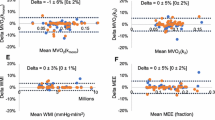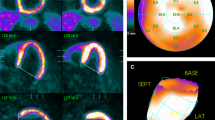Abstract.
The clearance kinetics of carbon-11 acetate, assessed by positron emission tomography (PET),can be combined with measurements of ventricular function for non-invasive estimation of myocardial oxygen consumption and efficiency. In the present study, this approach was applied to gain further insights into alterations in the failing heart by comparison with results obtained in normals. We studied ten patients with idiopathic dilated cardiomyopathy (DCM) and 11 healthy normals by dynamic PET with 11C-acetate and either tomographic radionuclide ventriculography or cine magnetic resonance imaging. A ”stroke work index” (SWI) was calculated by: SWI = systolic blood pressure × stroke volume/body surface area. To estimate myocardial efficiency, a ”work-metabolic index” (WMI) was then obtained as follows: WMI = SWI × heart rate/k(mono), where k(mono) is the washout constant for 11C-acetate derived from mono-exponential fitting. In DCM patients, left ventricular ejection fraction was 19%±10% and end-diastolic volume was 92±28 ml/m2 (vs 64%±7% and 55±8 ml/m2 in normals, P<0.001). Myocardial oxidative metabolism, reflected by k(mono), was significantly lower compared with that in normals (0.040±0.011/min vs 0.060± 0.015/min; P<0.003). The SWI (1674±761 vs 4736± 895 mmHg × ml/m2; P<0.001) and the WMI as an estimate of efficiency (2.98±1.30 vs 6.20±2.25×106 mmHg × ml/m2; P<0.001) were lower in DCM patients, too. Overall, the WMI correlated positively with ejection parameters (r=0.73, P<0.001 for ejection fraction; r=0.93, P<0.001 for stroke volume), and inversely with systemic vascular resistance (r=–0.77; P<0.001). There was a weak positive correlation between WMI and end-diastolic volume in normals (r=0.45; P=0.17), while in DCM patients, a non-significant negative correlation coefficient (r=–0.21; P=0.57) was obtained. In conclusion non-invasive estimates of oxygen consumption and efficiency in the failing heart were reduced compared with those in normals. Estimates of efficiency increased with increasing contractile performance, and decreased with increasing ventricular afterload. In contrast to normals, the failing heart was not able to respond with an increase in efficiency to increasing ventricular volume. The present data support the usefulness of the WMI for non-invasive characterization of cardiac efficiency and may serve as a background for improved evaluation of medical therapy for heart failure.
Similar content being viewed by others
Author information
Authors and Affiliations
Additional information
Received 10 August and in revised form 3 November 1999
Rights and permissions
About this article
Cite this article
Bengel, F., Permanetter, B., Ungerer, M. et al. Non-invasive estimation of myocardial efficiency using positron emission tomography and carbon-11 acetate – comparison between the normal and failing human heart. Eur J Nucl Med 27, 319–326 (2000). https://doi.org/10.1007/s002590050040
Issue Date:
DOI: https://doi.org/10.1007/s002590050040




